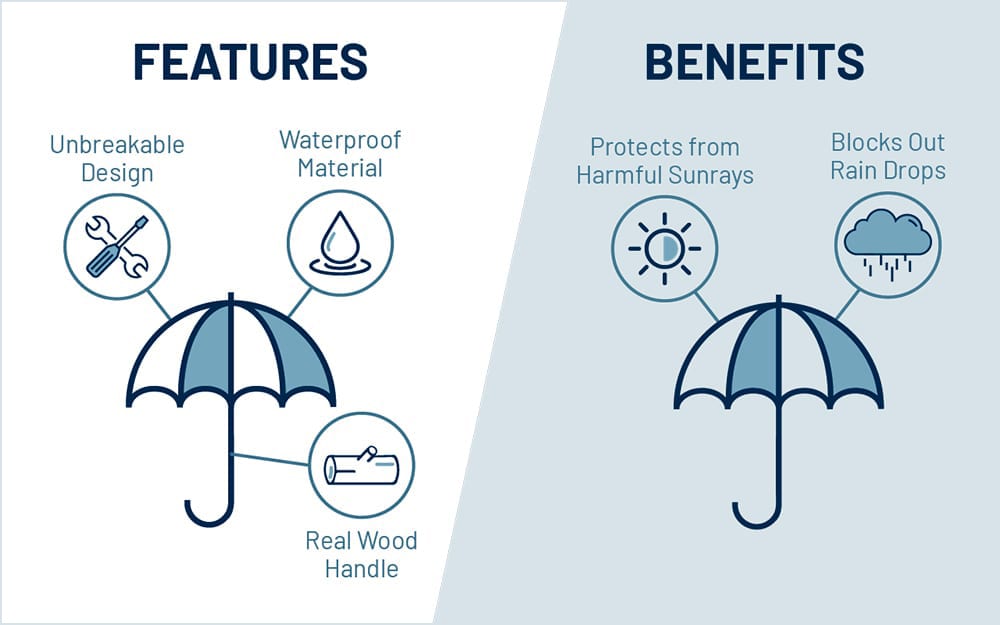The terms “features” and “benefits” are continually thrown around when people are discussing marketing strategies and communications tactics – most of the time, with a sentence, much like, “We need this brochure to have real features-and-benefits text throughout the whole piece.” At which point, everyone normally nods in agreement. Who could disagree? But of course, if you sked most of the people in the room, few could honestly agree either, because they’re not clear on what “features-and-benefits text” or “features/benefit format” actually means, including the person who commented. Why? Because it’s an expression that doesn’t really mean much of anything. It’s become marketing jargon.

Let’s clear up the confusion by first defining these two words.
Features: characteristics of a product, service, or another offer.
In other words, what are the pieces and parts of whatever it is you’re marketing?
For example, if you’re selling a car, some features might include airbags, a convertible top, and a potent engine. If you’re selling a management consulting service, some of the features might be 20 years of experience, an online project-tracking tool, and a helpful document that the client receives at the end of the process. Benefits: tangible or intangible positives that customers and clients receive or experience via a product, service, or another offer.
Related Articles :
Let’s consider the two examples above.
The three features listed for the car were
(1) airbags,
(2) convertible top, and
(3) powerful engine.
The corresponding benefits – expressed in terms of a customer – might be
(1) you’ll be safe,
(2) you can enjoy the beautiful weather, and
(3) you’ll be able to impress your high school buddies at your upcoming class reunion. (People don’t want airbags. They want to be safe.)
The three features of the consulting services were
(1) 20 years of experience,
(2) online project-tracking tool, and
(3) a document that clients receive at the end of the consulting gig.
The corresponding benefits to the clients might be
(1) you can be confident that the recommendations are based on proven philosophies and will therefore be effective,
(2) you’ll always know the status of the project, and
(3) you’ll be able to easily refer to all of the recommendations even after the engagement is done. (People don’t really want a consultant with 20 years of experience. They don’t even want recommendations that are based on proven philosophies. They want recommendations that will work.)
Of course, these are just three features for each product or service and one benefit for each feature. Each feature could probably be interpreted into dozens of benefits, depending on the specific audience members.
Here’s a quick (and very incomplete) list of benefits that could go along with the feature of a car being a convertible.
– You can enjoy the beautiful weather.
– You can enjoy the stars and moon.
– You can impress potential dates.
– Your kids (and their friends) will think you’re cool.
– You can enjoy better site-seeing trips.
– You will feel at one with nature.
– You won’t feel trapped in the car when making all those long business trips.
– You can spend less on electricity because you’ll no longer need a hairdryer.
Some of these benefits will be more relevant than others to different segments of your audience. Therefore, you have a couple of choices.
(1) You can segment your communications so that you’re delivering different benefits to different segments of your target audience, or
(2) you can tout the feature, allowing each audience member to instantly think of the benefit that’s most relevant to him or her.
That second option is sometimes the best solution for a couple of reasons – especially when every member of your target audience clearly understands your product or service and will correctly leap to the right conclusion. For example, it might no longer be necessary to explain to consumers that airbags lead to increased safety in the car scenario. People know that. You might be able to state that your car has eight airbags.
Another time you might choose to talk about the feature instead of the benefit is when you can’t really say the benefit. For example, the feature of 20 years of consulting experience could easily lead to the benefit of, “our recommendations are better than those of our competitors and will help make you rich.” However, you might not be able to say that, possibly because of legal limitations, or maybe because it just seems too boastful or unprofessional. In these situations, it often is best to say the feature and hope that the audience members assume the correct benefits. (You should then spend the rest of your marketing efforts focusing on other benefits that you can more blatantly discuss.)
But there’s yet another twist.
The airbag is a feature, and increased safety is the benefit. However, if you dig a little deeper, increased safety might also be a feature, and the benefit might be the increased peace of mind that your teenage son will be more likely to walk away from an accident if you buy him this car. That benefit is a little more specific, a little more personal, a little more emotional, and probably a little more effective of a marketing message.
